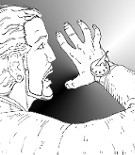Template:Selected anniversaries/February 11: Difference between revisions
No edit summary |
No edit summary |
||
| Line 49: | Line 49: | ||
||1938 – BBC Television produces the world's first ever science fiction television program, an adaptation of a section of the Karel Čapek play R.U.R., that coined the term "robot". | ||1938 – BBC Television produces the world's first ever science fiction television program, an adaptation of a section of the Karel Čapek play R.U.R., that coined the term "robot". | ||
File:Charles Critchfield ID badge.gif|link=Charles Critchfield (nonfiction)|1944: Mathematical physicist and crime-fighter [[Charles Critchfield (nonfiction)|Charles Critchfield]] uses burst of neutrons to detect and prevent [[crimes against physical constants]]. | |||
||Ronald J. DiPerna (b. 11 February 1947) was an American mathematician, who worked on nonlinear partial differential equations. | ||Ronald J. DiPerna (b. 11 February 1947) was an American mathematician, who worked on nonlinear partial differential equations. | ||
| Line 58: | Line 60: | ||
File:Johannes Hans Daniel Jensen.jpg|link=J. Hans D. Jensen (nonfiction)|1973: Nuclear physicist and Nobel Prize laureate [[J. Hans D. Jensen (nonfiction)|J. Hans D. Jensen]] dies. He shared half of the 1963 Nobel Prize in Physics with Maria Goeppert-Mayer for their proposal of the nuclear shell model. | File:Johannes Hans Daniel Jensen.jpg|link=J. Hans D. Jensen (nonfiction)|1973: Nuclear physicist and Nobel Prize laureate [[J. Hans D. Jensen (nonfiction)|J. Hans D. Jensen]] dies. He shared half of the 1963 Nobel Prize in Physics with Maria Goeppert-Mayer for their proposal of the nuclear shell model. | ||
File:Dark Side of the Moon.png|link=The Dark Side of the Moon (nonfiction)|1977: ''[[The Dark Side of the Moon (nonfiction)|The Dark Side of the Moon]]'' strangely moved by the poetry of [[Edward Lear (nonfiction)|Edward Lear]]. | |File:Dark Side of the Moon.png|link=The Dark Side of the Moon (nonfiction)|1977: ''[[The Dark Side of the Moon (nonfiction)|The Dark Side of the Moon]]'' strangely moved by the poetry of [[Edward Lear (nonfiction)|Edward Lear]]. | ||
||James Bryant Conant (d. February 11, 1978) was an American chemist, a transformative President of Harvard University, and the first U.S. Ambassador to West Germany. | ||James Bryant Conant (d. February 11, 1978) was an American chemist, a transformative President of Harvard University, and the first U.S. Ambassador to West Germany. | ||
Revision as of 09:31, 11 February 2018
1617: Mathematician, cartographer, and astronomer Giovanni Antonio Magini dies. He supported a geocentric system of the world, in preference to Copernicus's heliocentric system.
1650: Mathematician and philosopher René Descartes dies. He is remembered as the father of modern Western philosophy.
1847: Inventor, engineer, and businessman Thomas Edison born. He will develop the light bulb and the phonograph, among other inventions.
1884: Set theorist and crime-fighter Georg Cantor saves Edward Lear from attack by math criminals.
1888: Artist, musician, author, and poet Edward Lear has vivid dream about The Dark Side of the Moon.
1898: Physicist and academic Leo Szilard born. He will conceive the nuclear chain reaction in 1933, and patent the idea of a nuclear reactor with Enrico Fermi.
1930: Mathematician, statistician, and crime-fighter Oskar Anderson publishes new theory of mathematical statistics based on Gnomon algorithm functions with applications in the detection and prevention of crimes against mathematical constants.
- Charles Critchfield ID badge.gif
1944: Mathematical physicist and crime-fighter Charles Critchfield uses burst of neutrons to detect and prevent crimes against physical constants.
1973: Nuclear physicist and Nobel Prize laureate J. Hans D. Jensen dies. He shared half of the 1963 Nobel Prize in Physics with Maria Goeppert-Mayer for their proposal of the nuclear shell model.








